Amazon ranks product sales within categories on its website. That includes books. Amazon allows pre-orders (pre-sales) of e-books by both traditionally published and independent authors. In addition, traditional and independent authors both promote their books through non-Amazon sites and sources.
A few months ago—April 2, 2015 to be exact—I released Heaven to Betsy. I offered it for pre-order, as I had for my October 2014 release, Going for Kona. Amazon had just made pre-sale of e-books available to independent authors in the summer of 2014, so I had not been able to offer it on my previous books. This month, August 2015, I offered Earth to Emily for pre-order. Here’s how the sales went for each:

Because in the past pre-order sales dropped on release date, they impacted rankings tremendously, helping a book possibly attain “Hot New Release” status with Amazon, which propelled more sales and better rankings. With all the books I’ve offered for pre-order, Amazon also sent out announcement e-mails to those people who had bought my books before. So it’s been a pretty big advantage to get your e-book up for pre-order.
When I sold 213 pre-order e-books of Heaven to Betsy for its April 2, 2015 release, the result was that it was #18 in romantic mystery and nearly cracked the top 1000 overall on its first day of sales. That’s a bestseller, folks. It looked like this:
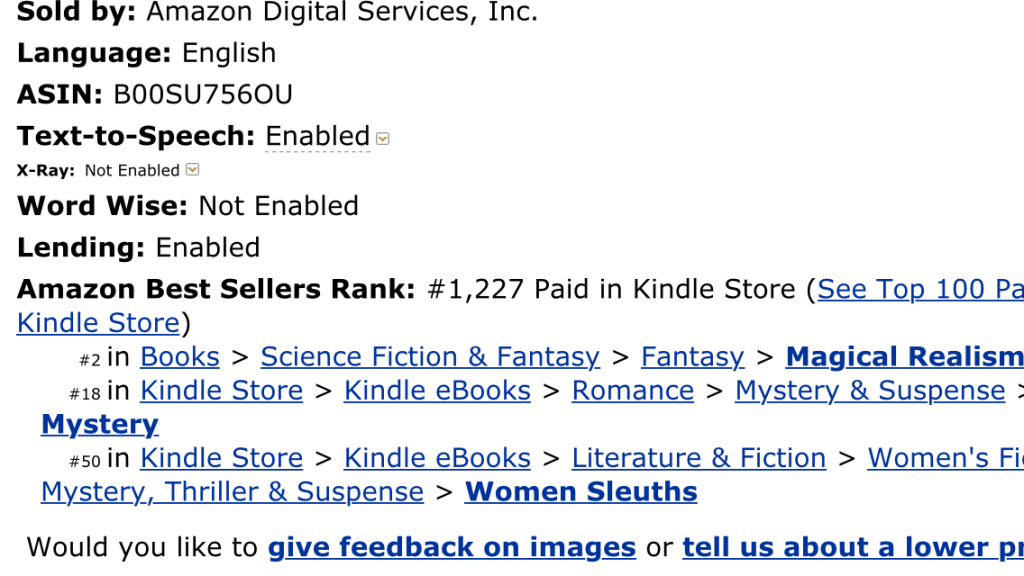
But it wasn’t a “Hot New Release,” so we tried harder for E2E, even though we’d started to hear rumblings of changes to the algorithms, that indie authors pre-order sales no longer counted on release day, and that promotion ranking spikes were being “smoothed”.
I sold 685 E2E via pre-order. Over three times as many as I sold of Heaven to Betsy. On release day (August 6), its ranking fell from 8,000 to over 11,000. Yes, you read that right. By the 2nd day the rankings started climbing and ultimately it reached #37 in romantic mystery on day three and cracked the top 2000. It did not make it as a Hot New Release. Obviously. But why was its rank so much lower than H2B‘s with triple the pre-orders? (First, a look at the screen shots: E2E‘s rank on its day three peak; overall sales at the end of day 3, August 8; the romantic mystery rankings—which included four of my novels, so I can’t complain too much; the free download rankings, which my Saving Grace led; the author rank, in which I was #30 in category.)

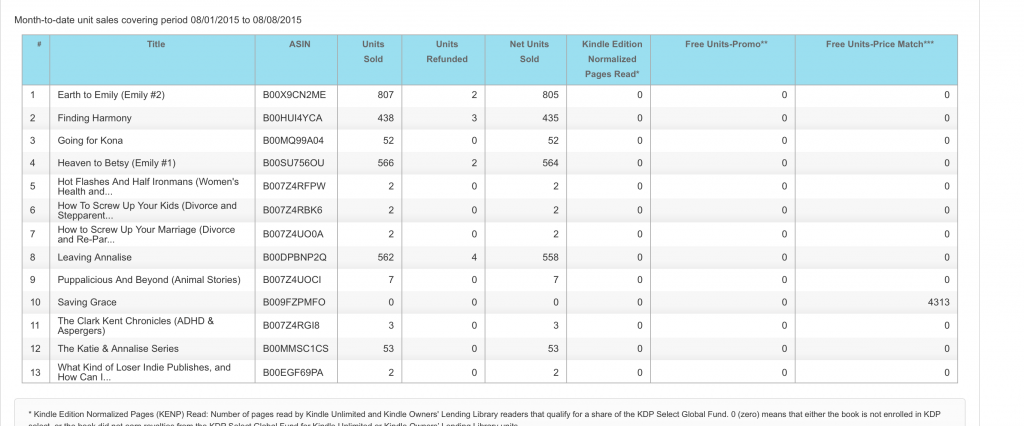
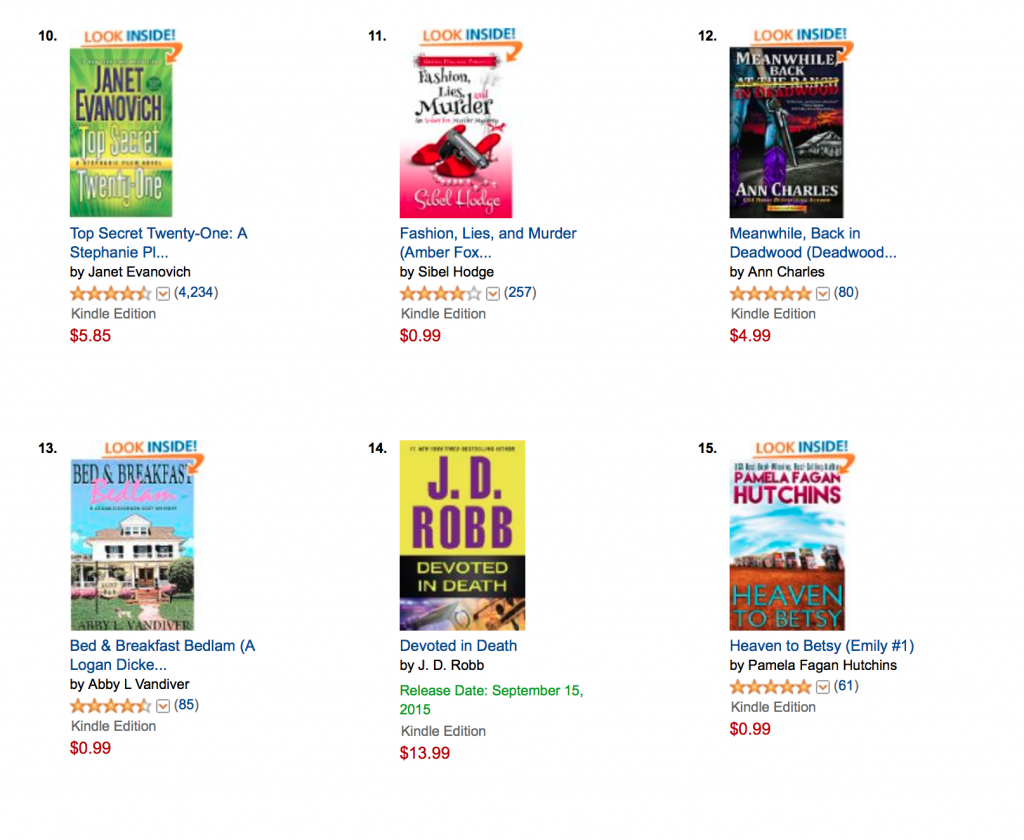
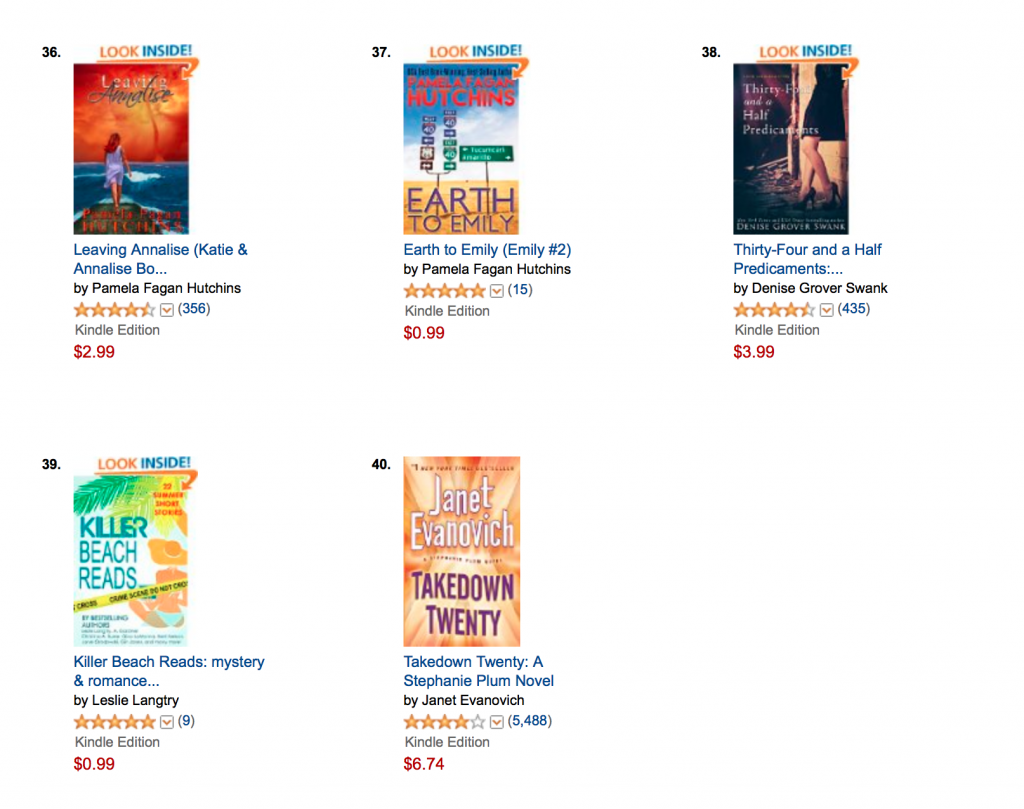
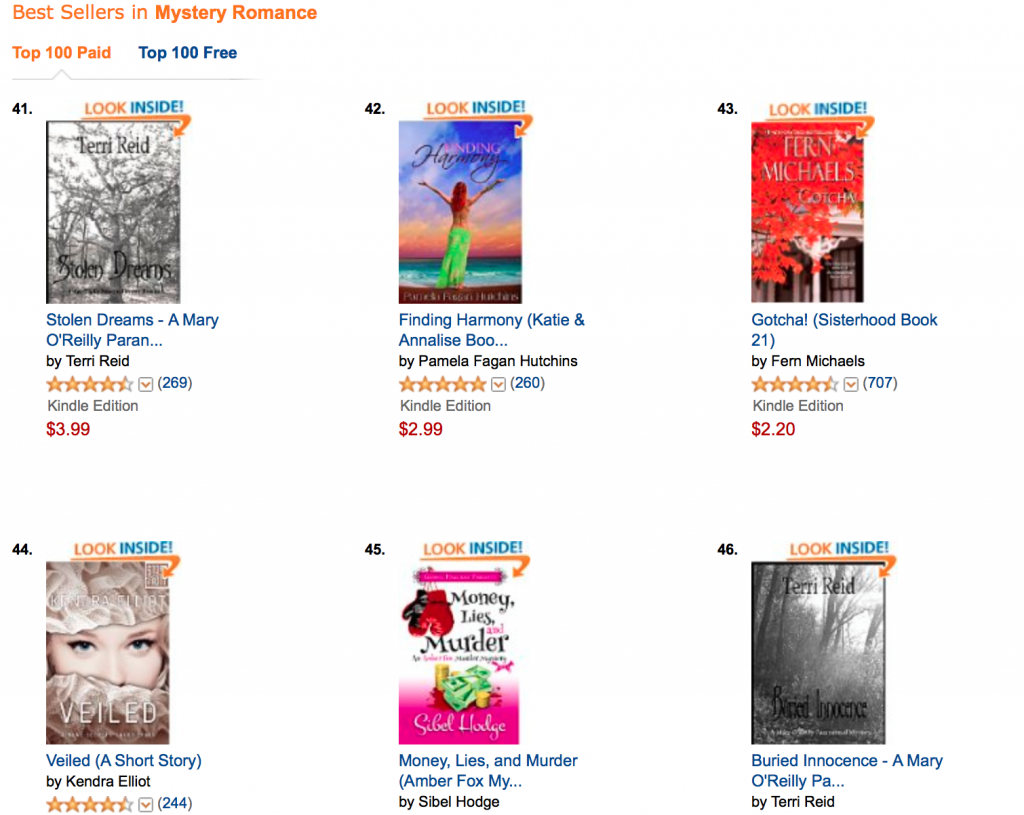
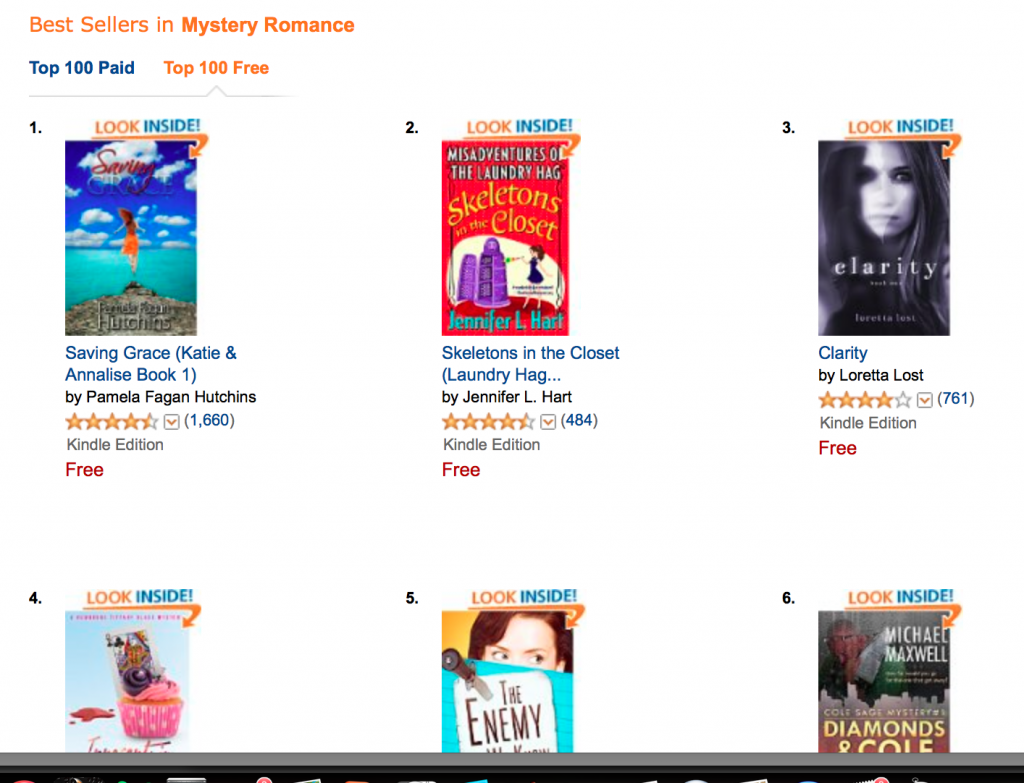

It turned out that it was true that Amazon is smoothing the impact of spikes caused by promotions and pre-orders, in favor of sustained sales. A longer averaging period, if you will. Pre-orders counted, for indies, at the time of the sale rather than on release day. Why else would H2B sell only 566 compared to E2E’s over 800 in the same period, and H2B be ranked 15 while E2E was ranked 37? That’s not evil, really, but it does decrease the impact of the enormously successful Bookbubs and the BookSends, and, yes, the pre-orders, for indies.
Now we have the data to prove the change between April and August of 2015, but we’d hoped we wouldn’t, that we’d have data showing the opposite, because we certainly hadn’t seen it dramatically with our promotions, so we hadn’t been sure. In retrospect, that is probably because we were already selling a good number of books, steadily, but our May and and summer promos weren’t as “spikey,” if you will.
Rats. Like I said, though, I can’t complain too much. I’ll still complain a little though. Because 213 pre-orders was such a success, we really had counted on great things from 685 pre-orders, thus it was a tremendous disappointment, and, strategically, we would have run more paid promotions on days 2-7 for E2E had we known of Amazon’s algorithm change. By the time we figured it out, it was too late to book the promotions, so the rankings fell.
Hell to Pay (Emily #3) is coming out in 2016, so we’ll just have to see what we see then, vis a vis pre-order impacts. I’ll still do pre-orders, just a compressed period for them. I want Amazon to send that e-mail to all my readers. 🙂
Have any of the rest of you seen a smoothing of spikes in your rankings on Amazon, post promotion, or post pre-orders? I’d love to hear your experiences, and so would my readers. Please do share in the comments below.
And over the next few weeks, I am posting on two purely positive new developments on Amazon, I promise: Amazon giveaways and Amazon new release author emails to followers.
Pamela
Pamela Fagan Hutchins writes overly long e-mails, award-winning and best-selling mysteries,  and hilarious nonfiction, chairs the board of the Houston Writers Guild, and dabbles in employment law and human resources investigations from time to time. She is passionate about great writing, smart authorpreneurship, and her two household hunks, husband Eric and one-eyed Boston terrier Petey. She blogs on writing, publishing and promotion at Skip the Jack and on her beleaguered family, and much-too-personal life at Road to Joy. She also leaps medium-tall buildings in a single bound (if she gets a good running start). Check out her USA Best Book Award winning novel, Going for Kona, her permafree mystery (and series lead), Saving Grace, her writing/publishing/promotion Bible, What Kind of Loser Indie Publishes, and How Can I Be One, Too?, her newest mystery, Earth to Emily (Emily #2).
and hilarious nonfiction, chairs the board of the Houston Writers Guild, and dabbles in employment law and human resources investigations from time to time. She is passionate about great writing, smart authorpreneurship, and her two household hunks, husband Eric and one-eyed Boston terrier Petey. She blogs on writing, publishing and promotion at Skip the Jack and on her beleaguered family, and much-too-personal life at Road to Joy. She also leaps medium-tall buildings in a single bound (if she gets a good running start). Check out her USA Best Book Award winning novel, Going for Kona, her permafree mystery (and series lead), Saving Grace, her writing/publishing/promotion Bible, What Kind of Loser Indie Publishes, and How Can I Be One, Too?, her newest mystery, Earth to Emily (Emily #2).
Hi, Pamela. This is what I’ve heard, and supposedly has been the deal for quite a while. It meshes with my personal experience as well.
If you’re Indie, preorders on Amazon count toward your ranking on the day they are ordered. The don’t do anything for you on release day. Amazon only does the spike for traditionally published books. However, other venues like Kobo, etc, do the spike for Indies. This isn’t helpful if you are in KDP Select, obviously.
Seems a bit unfair! And really, it means that preorders on Amazon can be more of a liability than an asset. I am still using them, but severely shortening my preorder period.
Yes, that’s our conclusion too. We were so thrilled in April. So bummed in August. I want the email to my readers from Amazon, but I don’t want the long pre-order period anymore.
There are lots of behind the scene deals where big money nets big advantages.
I was under the impression that preorder sales count the day the preorder is made. (If you notice, you’re book that is listed as a preorder does have a ranking). So that “big spike” you see on release day when your preorders drop isn’t counted on that day. It’s counted the day it was purchased (likely weeks prior).
Sorry…just noticed my comment is redundant! And has a spelling error! 😛
Yes, now. Not last April, which was really the point of this post (that we have data to illustrate the change between April and August), And not for traditionally published books, or at least not completely. Their algorithm is a bit different, so we have heard and ao it appears. Anyway, I edited the post a little bit to reflect what we learned earlier, since it’s drawing the same comments. Good comments, by the way 🙂
Yeah the change really caught us by surprise and will make us rethink the idea of doing a discounted pre-order period. The reason for doing it with a new release of course is to get that really big opening day bang in the ratings that we had seen in the past. If that is no longer there then we probably need to rethink the strategy.
It’s interesting we didn’t see the impact of the change on our promotions. I guess sales never dropped enough for it to really show. But in retrospect, the rankings could have been higher on some of the promos, and this is why. The great unknown is why B&N dried up so much for awhile and has stayed so much lower than Apple. Other than the obvious reasons, of course. Did something else change besides loss of market share and sparse international distribution.
Pingback: New and Nifty Feature: Author e-mails to Amazon Followers | We indie publish, and skip all the jack.
Thanks so much for this article! I was just trying to decide whether to set pre-orders or not and the info in this piece of writing has very much helped me to make up my mind 🙂 Kindest regards, Roisin Black.
We are glad it helped. According to Mark Coker of Smashwords, 2/3 of their bestsellers were offered on pre-order yet only 10% or so of books on smashwords were offered pre-order. We think that’s a telling statistic. To us it’s not a question of whether to use pre-orders, but how to best use them. I’ll share this, Roisin: Pamela was going to decrease the length of the pre-order of her next novel, but she got a Bookbub whose timing led her to decide to use a 90-day Amazon Kindle pre-order period after all, so that she would have the pre-order available for people who cycled through all of her books post Bookbub. 🙂 Circumstances dictate strategy, and flexibility is the key to air power.
Eric, it all makes my head hurt…
Mine too. We saw a lot more evidence of the smoothing with the most recent Bookbub promotions our authors did: the sales and downloads were as high or higher but the rankings, while great, weren’t as stunning as before the summer of 2015. But then again, we’re also feeling the effects of 600,000 indie books per year on the market, and the usual 300,000 traditional. Readers have a lot to choose from, and it makes their heads hurt too. Another day, another deal. Kindles are loaded full. Discoverability/visibility (and keeping it) is getting harder.
It sure is! Sometimes I despair but then I keep going because if I know one thing in all of this it’s if I give up then that’s a sure-fire way to failure! So with that being a basic truth – there is no choice but to keep going….
Very true. The savvy business person has the advantage in this market. So we will just be THAT, along with the wonderful books.
I think that’s going to be the differentiator going forward Eric!